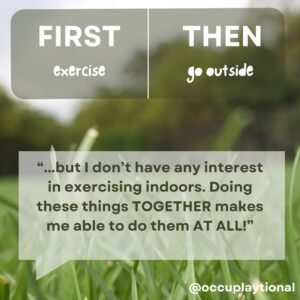Imagine that you sit down to watch a movie. You pop yourself a bowl of popcorn to go with it…maybe your favorite toppings, whether salt and butter or marshmallow or Parmesan cheese or something else…you pick up the remote, hit play, and get ready to watch the movie while eating your popcorn.
Then somebody takes the bowl away from you and frowns in your face. “FIRST, watch the movie. THEN, eat popcorn,” they announce.
Imagine you’re going to drive your car to an appointment about 20 minutes away. Some alone time! You get the directions pulled up on your GPS, and start the sound of your favorite playlist.
But before you can shift the car into gear, someone reaches over and turns off the song. “FIRST, drive to appointment. THEN, listen to music.”
Imagine it’s warming up outside and you’ve been working indoors in a stuffy room for too long today. You’re thinking maybe you’ll go for a walk or even a jog, get your heart rate up, fresh air in your lungs, and sun on your skin.
You go to put your hand on the doorknob and find it locked. Somebody shakes their head and says condescendingly: “FIRST, exercise. THEN, go outside.”
You might find yourself thinking or feeling all kinds of things in these scenarios. “This is completely arbitrary! Who says I can’t do these two things at the same time? Actually, I could probably do the first thing BETTER if I was doing the second thing in tandem with it. It might make my leisure more enjoyable to combine things I love. It might make a chore more relaxing and less anxious to give myself access to a lovely sensory experience in the meantime. It might even give me the ability to do the thing at all; I don’t have any interest in exercising sullenly indoors! Why do I have to separate these things out into a schedule?”
Of course there are some things where you have to do them sequentially. You can’t drive a car while watching a movie at the same time. You have to do either one or the other first. You might be able to do your favorite one first. Or you might not be able to. Sometimes life is like that.
Of course there are some times where your focused attention narrows your actions to just one thing at a time. Maybe you get close to the parking lot and you turn off your music so you can focus on finding a spot. Maybe at a climactic point in the movie you stop eating popcorn because all your focus is on the screen and what’s going to happen. Then, when the tension dissipates, you put another kernel in your mouth.
“First/then” is a meaningful intervention for a child when its purpose is to talk to them about a schedule. For a child who might be overwhelmed by knowing all 12 steps that are gonna happen in an entire day, or who needs special focus on what’s happening right now and what will happen next, first/then can be really useful. “First we will go to recess, then we will go to lunch” is a useful statement for many children. It helps their brain begin preparing for lunch before they have to be ready for it right away. It helps them know what kinds of transitions to expect. Its intention is to share information and awareness.
“First/then” is NOT a meaningful intervention for a child when its purpose is to dangle a reward in front of them but remind them that they can’t have it until they comply. For a child who is struggling to do the thing you want them to do, reminding them that you’re withholding something they love until they stop fighting and do what you want is not helpful. “First we will do math, then you get a five minute break” is literally acknowledging and reinforcing, “Math sucks and you should only do it if someone bribes you.” Its intention is to reward, which is really just the other half of the punishment coin.
If the kid in the first scenario chooses to sit quietly on the bench the entire time of recess because they feel a bit overwhelmed by the whole recess thing, they still get lunch. If the kid in the second scenario chooses to sit quietly at their desk the entire time of math because they feel a bit overwhelmed by the whole math thing, they get their break withheld from them. That’s the difference I’m talking about.
So what do you do instead? Consider how to combine the two elements, like what I described in the first half of this post with my 3 adult examples. Can you combine two things they love? Can you provide access to a positive sensory experience in the meantime? Can you give them the ability to do the thing at all? If taking the break after math would usually involve playing with plastic dinos, maybe the plastic dinos should be the subject of the math—the manipulatives being counted, or the make-believe “students” being asked the question.
Maybe you can eat (or hold) a snack while you climb into a car seat.
Maybe you can get dressed while you listen to a favorite audiobook.
Maybe you can fidget and stim while you’re in the classroom.
Maybe you can practice articulation sounds while you play with the favorite toy.
Of course there are times when there are naturally occurring (not adult-imposed arbitrary) sequential things. Of course there are times where there are naturally occurring (not adult-imposed arbitrary) things that require singular attention.
But if we’re creative, a lot of times, FIRST we can reconsider how we’re going to do something, and THEN we can make it more meaningful and less of a behavioral bribe. 😉




